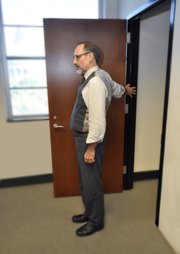Sitting for hours on end at our desk creates tension and tightness through the neck, shoulders, back and hips. Here are a few stretches you can do to relieve tension and re-energize your body and mind. Photo by Trip Burns.
This is part three in an instructional yoga series, each part focused on yoga positions for different purposes.
Sitting for hours on end at our desk creates tension and tightness through the neck, shoulders, back and hips. Here are a few stretches you can do to relieve tension and re-energize your body and mind.
Model: Malcolm White, director of the Tourism Division at Mississippi Development Authority
Age: 56
Yoga Wall Clock
Stand with your right side a few inches from a wall. Inhale and stretch your right arm straight up (as if at the 12 o'clock position) and place your palm flat on the wall.Keeping your chin parallel to the floor and your ears over your shoulders, draw your shoulder blade toward your spine (adduction).Take three to five breaths and shift your arm to a 1 o'clock position.Take a few breaths and shift to a 2 o'clock position. After a few more breaths, shift again to a 3 o'clock position. Release and repeat with your left arm.
Do:
• Breathe steady.
• Keep your chin parallel to the floor.
• Glide your ears back over your shoulders.
• Step further from the wall if the stretch is too intense.
• Consult your physician if you have a rotator cuff or other shoulder injury.
Don't:
• Force the stretch.
• Do this stretch if you feel acute pain in the shoulder joint.
Benefits:
• Stretches the chest and anterior shoulder muscles.
• Combats forward hunch of the shoulders.
• Releases tension in the upper back.
• Energizes the body.
Seated Spinal Twist
Sit in your chair with your feet flat, hip-width apart and parallel to each other. Keep your knees directly above your ankles. Lift your chin parallel to the floor and glide your ears back over your shoulders. Press your sitting bones down, inhale and lengthen your spine. Keep your chin in line with your sternum and, as you exhale, draw your navel toward your spine and twist to your right. Hold on to the arm or back of your chair. Lengthen your spine with each inhalation. Draw your navel toward your spine and deepen your twist as you exhale. After twisting as far as you can comfortably, look over your right shoulder.
Hold for three to five breaths. Maintaining the length of your spine, gently unwind and repeat to the left side.
Do:
• Keep your knees level and parallel to each other during the twist.
• Keep your chin parallel to the floor.
• Maintain length in your spine.
• Relax your shoulders.
• Back out of the twist if it is painful or difficult to breathe.
• Consult your physician if you have a spinal injury.
Don't:
• Let one knee go further forward than the other.
• Force the twist.
Benefits:
• Relieves tension.
• Improves flexibility of the spine.
• Stretches hips, shoulders and neck.
Desk Downward Dog
Place your hands palms flat on your desk shoulder width apart. Bend your knees and walk your feet back. Keep your hips over your feet and lower your torso until your body creates (or comes close to creating) a right angle. Engage your core to protect your lower back, and press back through your hips to help extend your spine. Slowly straighten your legs if you can without pain in your lower back. Relax your shoulders. Breathe steady for five to 10 breaths.
Do:
• Press your palms actively onto your desk.
• Bend your knees if the stretch is too intense for your hamstrings or your back is excessively rounded.
• Find a qualified instructor if you have a shoulder injury.
Don't:
• Pinch your shoulder blades together.
• Do this pose if you have acute pain in the shoulder joint.
Benefits:
• Relieves low back pain.
• Releases tension in the neck and upper back.
• Stretches spine, chest, shoulders, back, and hamstrings.
• Relieves fatigue.
• Therapeutic for high blood pressure.
Seated Hip Stretch
Sitting in your chair with feet flat, cross your right ankle over your left knee (or ankle, if that's not possible). Inhale and lengthen your spine. Exhale and flex (bend forward at) your hip, placing your hands or your crossed forearms on your desk. Relax your shoulders and neck.
Do:
• Breathe steady.
• Keep your spine long.
• Consult your physician if you've had a hip replacement.
Don't:
• Force the stretch.
• Continue the stretch if you feel acute pain in your hip or knee joint.
Benefits:
• Stretches thighs, groins and external rotators of the hips.
• Stimulates abdominal organs.
Wrist Stretches
Place both feet flat on the floor hip distance apart. Stretch your right arm out in front of you with your palm up. Use your left hand to draw your fingers down toward the floor to flex your wrist. Repeat with your left arm outstretched, and then repeat the sequence with your palm down.
Do:
• Breathe steady.
• Relax your face and shoulders.
• Consult your doctor if you have pain or numbness.
Don't:
• Force the stretch.
• Do if you have an acute wrist injury because it can cause pain in the wrist joint.
Benefits:
• Maintains mobility of the muscles and tendons in the wrist and forearm.
• Helps prevent repetitive strain injuries and Carpal Tunnel Syndrome.







